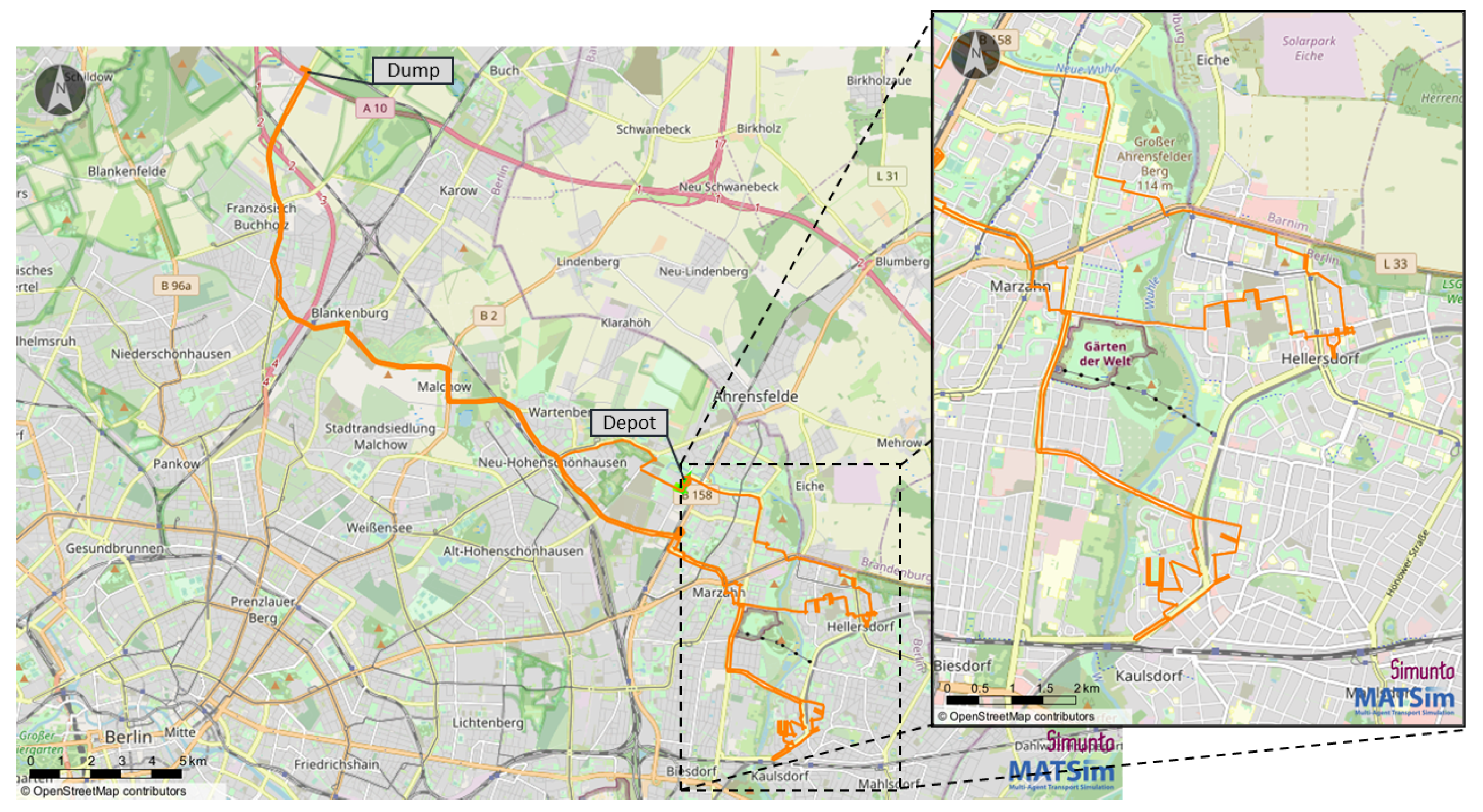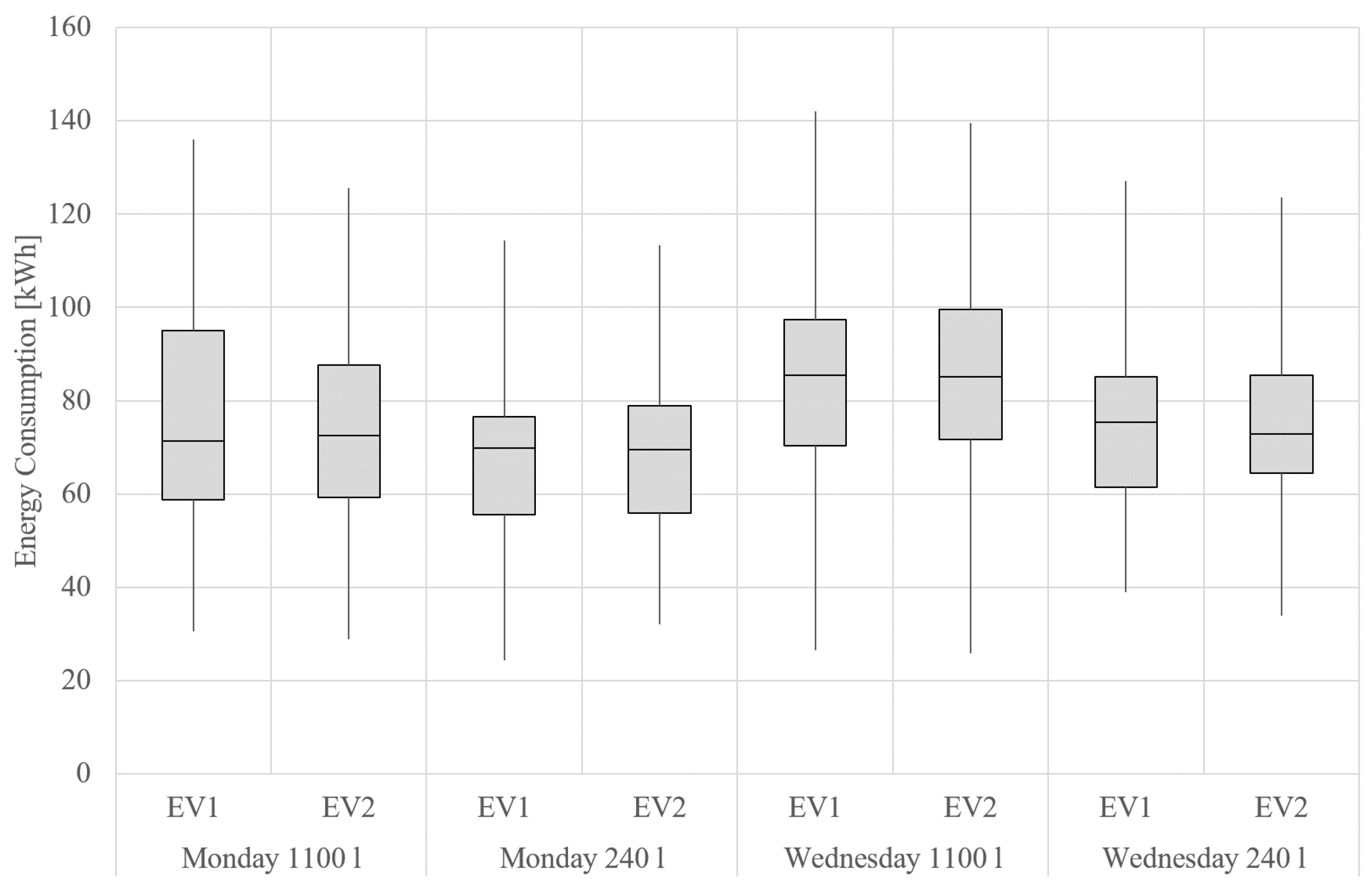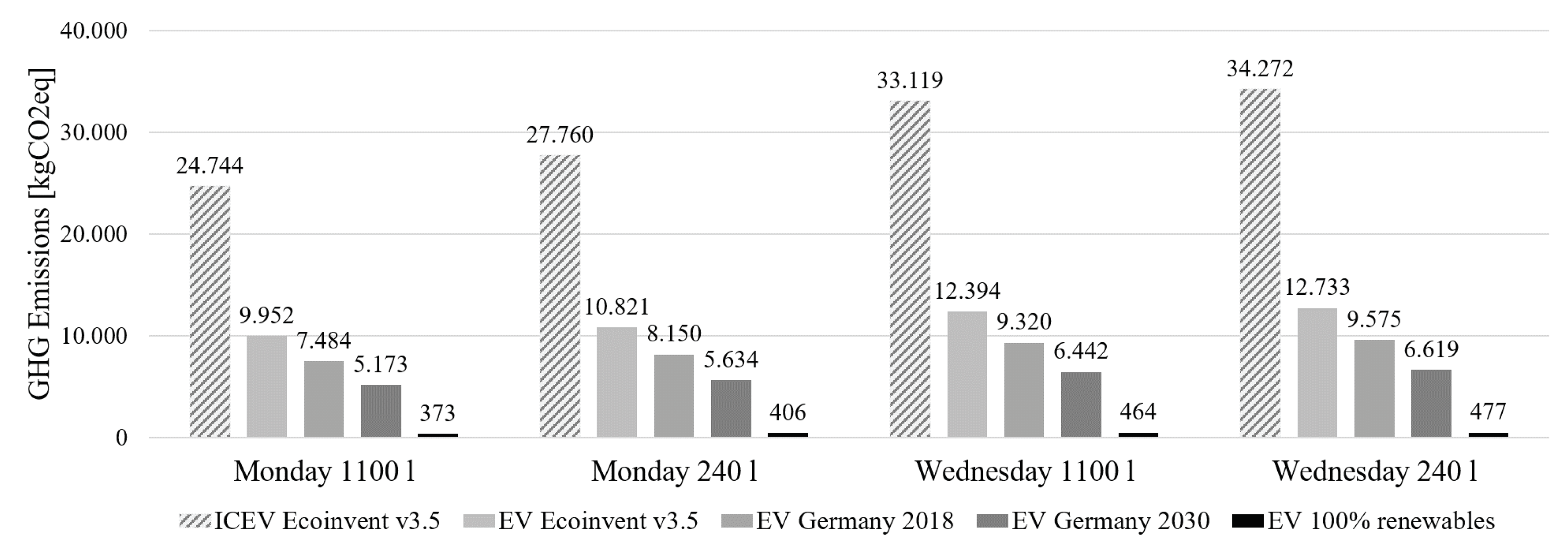Electrification of Urban Waste Collection: Introducing a Simulation-Based Methodology for Technical Feasibility, Impact and Cost Analysis
Abstract
:1. Introduction and Motivation
- How will fixed and variable costs differ between the fossil and the electric approach?
- How will tour structure and lengths as well as fleet size change?
- How can urban waste collection be realistically modelled and simulated in order to assess the costs and environmental impacts of different propulsion types?
2. State of the Art
- Generation of demand for pickups
- Generation of pickup tours
- Cost matrix for the pickup tours
- Technology and operational parameters of waste collection vehicles
2.1. Demand Generation for Waste Collection
2.2. Tour Generation
2.3. Cost Matrix/Road Network
2.4. Urban Electric Commercial Vehicles
2.4.1. Battery Price
2.4.2. Battery Lifetime
2.4.3. Driving Consumption
3. Methods
3.1. Transport Simulation: From Demand Generation to Vehicle Trajectories
- Building a model of the base case (ICEV)
- Building a model of the policy case
- Comparing costs and benefits
3.2. Total Cost of Ownership
3.3. Well-to-Wheelanalysis
4. Case Study
4.1. Road Network
4.2. Generating a Synthetic Demand for Waste Collection
- All collection vehicles have capacity (payload) constraints and thus have to unload at the dumps. Each disposal of a fully loaded vehicle is assumed to take 45 min, which is also assumed to be used as the legally required break of the vehicle crew.
- All collection vehicles have time constraints. They need to be back at the depot after 8 h and the earliest departure is 6 a.m.
4.3. Vehicle Parameters
4.4. Charging Infrastructure Parameters
5. Results
5.1. Base Case: Collection with Diesel Vehicles
- Volume of each waste bin: 1.1 m
- Service time per waste bin: 41 s
- Number of shipments: 12,113 (Monday), 17,808 (Wednesday)
- Waste to collect: 3123 tons (Monday), 3100 tons (Wednesday)
5.2. Policy Case: Collection with Electric Vehicles
5.3. Discussion of Tour Optimization Results
- The number of vehicles went down as 14, 14, 13 and 12.
- The average kilometers per vehicle went as 68, 67, 72 and 81.
- The maximum number of kilometers of any vehicle went as 101, 99, 99 and 98.
5.4. Total Cost of Ownership
5.5. Well-to-Wheel Analysis
6. Conclusions and Outlook
Author Contributions
Funding
Acknowledgments
Conflicts of Interest
References
- Europäische Kommission. Der europäische Grüne Deal, Brussels; COM(2019) 640 Final. 2019. Available online: https://eur-lex.europa.eu/legal-content/DE/ALL/?uri=CELEX:52019DC0640 (accessed on 16 August 2021).
- BMU. Klimaschutzplan 2050: Klimaschutzpolitische Grundsätze und Ziele der Bundesregierung; Technical Report; Bundesministerium für Umwelt, Naturschutz und nukleare Sicherheit (BMU): Berlin, Germany, 2016. [Google Scholar]
- WHO Regional Office for Europe. Review of Evidence on Health Aspects of Air Pollution—REVIHAAP Project: Technical Report; WHO Regional Office for Europe: Copenhagen, Danmark, 2013. [Google Scholar]
- Ansari Esfeh, M.; Kattan, L. A new design and evaluation approach for managed lanes from a sustainability perspective. Int. J. Sustain. Transp. 2019, 14. [Google Scholar] [CrossRef]
- DFG-GEPRIS—Analyse von Strategien zur Vollständigen Dekarbonisierung des Urbanen Verkehrs. 2018. Available online: https://gepris.dfg.de/gepris/projekt/398051144?context=projekt&task=showDetail&id=398051144& (accessed on 2 June 2021).
- Bischoff, J.; Maciejewski, M. Electric taxis in Berlin—Analysis of the feasibility of a large-scale transition. In Tools of Transport Telematics; Mikulski, J., Ed.; Springer International Publishing: Cham, Switzerland, 2015. [Google Scholar] [CrossRef]
- Bischoff, J.; Maciejewski, M. Simulation of City-wide Replacement of Private Cars with Autonomous Taxis in Berlin. Procedia Comput. Sci. 2016, 83, 237–244. [Google Scholar] [CrossRef] [Green Version]
- Jefferies, D.; Göhlich, D. Integrated TCO Assessment of Bus Network Electrification Considering Rescheduling and Delays: Modelling Framework and Case Study. In Proceedings of the 31st International Electric Vehicle Symposium & Exhibition & International Electric Vehicle Conference EVS 31 & EVTeC, Kobe, Japan, 1 October 2018. [Google Scholar]
- Gao, Z.; Lin, Z.; Davis, S.; Birky, A. Quantitative Evaluation of MD/HD Vehicle Electrification using Statistical Data. Transp. Res. Rec. J. Transp. Res. Board 2018, 2672, 109–121. [Google Scholar] [CrossRef]
- Göhlich, D.; Gräbener, S. Identification of User-oriented Electric Commercial Vehicle Concepts with a Particular Focus on Auxiliaries. In Proceedings of the 25th Aachen Colloquium Automobile and Engine Technology, Aachen, Germany, 10–12 October 2016. [Google Scholar]
- Goes, G.; Bandeira, R.; Gonçalves, D.; de Almeida D’Agosto, M.; Oliveira, C. The effect of eco-driving initiatives toward sustainable urban waste collection. Int. J. Sustain. Transp. 2019, 14, 569–578. [Google Scholar] [CrossRef]
- Graebener, S.; Tarnowski, M.; Goehlich, D. Multi-Dimensional Value-Benefit Analysis for Electrified Commercial Vehicle Concepts. In Proceedings of the 2015 IEEE Vehicle Power and Propulsion Conference (VPPC), Montreal, QC, Canada, 19–22 October 2015; pp. 1–5. [Google Scholar] [CrossRef]
- Du, J.; Ouyang, D. Progress of Chinese electric vehicles industrialization in 2015: A review. Appl. Energy 2017, 188, 529–546. [Google Scholar] [CrossRef]
- Ziemke, D.; Kaddoura, I.; Nagel, K. The MATSim Open Berlin Scenario: A multimodal agent-based transport simulation scenario based on synthetic demand modeling and open data. Procedia Comput. Sci. 2019, 151, 870–877. [Google Scholar] [CrossRef]
- Arribas, C.; Blazquez, C.; Lamas, A. Urban solid waste collection system using mathematical modelling and tools of geographic information systems. Waste Manag. Res. J. Int. Solid Wastes Public Clean. Assoc. ISWA 2009, 28, 355–363. [Google Scholar] [CrossRef]
- Beigl, P.; Lebersorger, S.; Salhofer, S. Modelling municipal solid waste generation: A review. Waste Manag. 2008, 28, 200–214. [Google Scholar] [CrossRef]
- Ghose, M.; Dikshit, A.; Sharma, S. A GIS based transportation model for solid waste disposal—A case study on Asansol municipality. Waste Manag. 2006, 26, 1287–1293. [Google Scholar] [CrossRef]
- Willemse, E. Using Data Science to analyse waste collection activities. Res. Focus 2018, 13, 38–40. [Google Scholar]
- Anghinolfi, D.; Paolucci, M.; Robba, M.; Taramasso, A. A dynamic optimization model for solid waste recycling. Waste Manag. 2012, 33. [Google Scholar] [CrossRef] [PubMed]
- Ghiani, G.; Guerrieri, A.; Manni, A.; Manni, E. Estimating travel and service times for automated route planning and service certification in municipal waste management. Waste Manag. 2015, 46, 40–46. [Google Scholar] [CrossRef] [PubMed]
- Irnich, S.; Toth, P.; Vigo, D. The Family of Vehicle Routing Problems. In Vehicle Routing: Problems, Methods, and Applications, Second Edition; Number 18 in MOS-SIAM Series on Optimization; SIAM: Bologna, Italy, 2014; pp. 1–33. [Google Scholar]
- Willemse, E.J. Heuristics for Large-Scale Capacitated arc Routing Problems on Mixed Networks. Ph.D. Thesis, University of Pretoria, Pretoria, South Africa, 2016. [Google Scholar]
- Hannan, M.A.; Akhtar, M.; Begum, R.; Basri, H.; Hussain, A.; Scavino, E. Capacitated vehicle-routing problem model for scheduled solid waste collection and route optimization using PSO algorithm. Waste Manag. 2017, 71. [Google Scholar] [CrossRef] [PubMed]
- Laureri, F.; Robba, M. An algorithm for the optimal collection of wet waste. Waste Manag. 2015, 48. [Google Scholar] [CrossRef]
- Martins-Turner, K.; Nagel, K. How driving multiple tours affects the results of last mile delivery vehicle routing problems. Procedia Comput. Sci. 2019, 151, 840–845. [Google Scholar] [CrossRef]
- Nykvist, B.; Sprei, F.; Nilsson, M. Assessing the progress toward lower priced long range battery electric vehicles. Energy Policy 2019, 124, 144–155. [Google Scholar] [CrossRef]
- Bloomberg New Energy Finance. Electric Vehicle Outlook 2019; Technical Report; Bloomberg New Energy Finance: London, UK, 2019. [Google Scholar]
- Hacker, F.; von Waldenfels, R.; Mottschall, M. Wirtschaftlichkeit von Elektromobilität in Gewerblichen Anwendungen; Technical Report; Öko-Institut e.V: Berlin, Germany, 2015. [Google Scholar]
- Schimpe, M.; von Kuepach, M.E.; Naumann, M.; Hesse, H.C.; Smith, K.; Jossen, A. Comprehensive Modeling of Temperature-Dependent Degradation Mechanisms in Lithium Iron Phosphate Batteries. J. Electrochem. Soc. 2018, 165, A181–A193. [Google Scholar] [CrossRef] [Green Version]
- Schmalstieg, J.; Käbitz, S.; Ecker, M.; Sauer, D.U. A holistic aging model for Li(NiMnCo)O2 based 18650 lithium-ion batteries. J. Power Sources 2014, 257, 325–334. [Google Scholar] [CrossRef]
- Sauer, D.U.; Sinhuber, P.; Rogge, M.; Rohlfs, W.; Winter, M. Entwicklungen im Batteriebereich—Auswirkungen auf Planung, Betrieb und Sicherheit von Elektrobussen und Ladeinfrastruktur. In Proceedings of the 7 VDV-Akademie Konferenz Elektrobusse—Markt der Zukunft! Berlin Germany, 29 February–1 March 2016; p. 49. [Google Scholar] [CrossRef]
- Matadi, B.P.; Geniès, S.; Delaille, A.; Chabrol, C.; de Vito, E.; Bardet, M.; Martin, J.F.; Daniel, L.; Bultel, Y. Irreversible Capacity Loss of Li-Ion Batteries Cycled at Low Temperature Due to an Untypical Layer Hindering Li Diffusion into Graphite Electrode. J. Electrochem. Soc. 2017, 164, A2374–A2389. [Google Scholar] [CrossRef]
- Yang, X.G.; Zhang, G.; Ge, S.; Wang, C.Y. Fast charging of lithium-ion batteries at all temperatures. Proc. Natl. Acad. Sci. USA 2018, 115, 201807115. [Google Scholar] [CrossRef] [Green Version]
- Sripad, S.; Viswanathan, V. Performance Metrics Required of Next-Generation Batteries to Make a Practical Electric Semi Truck. ACS Energy Lett. 2017, 2, 1669–1673. [Google Scholar] [CrossRef] [Green Version]
- Kivekäs, K.; Vepsäläinen, J.; Tammi, K. Stochastic Driving Cycle Synthesis for Analyzing the Energy Consumption of a Battery Electric Bus. IEEE Access 2018, 6, 55586–55598. [Google Scholar] [CrossRef]
- Horni, A.; Nagel, K.; Axhausen, K.W. (Eds.) The Multi-Agent Transport Simulation MATSim; Ubiquity: London, UK, 2016. [Google Scholar] [CrossRef]
- Geissdörfer, K.; Gleich, R.; Wald, A. Standardisierungspotentiale lebenszyklusbasierter Modelle des strategischen Kostenmanagements. Z. Für Betriebswirtschaft 2009, 79, 693–715. [Google Scholar] [CrossRef]
- Götze, U.; Weber, T. ZP-Stichwort: Total Cost of Ownership. Z. Für Plan. Unternehmenssteuerung 2008, 19, 249–257. [Google Scholar] [CrossRef]
- Goehlich, D.; Spangenberg, F.; Kunith, A. Stochastic total cost of ownership forecasting for innovative urban transport systems. In Proceedings of the 2013 IEEE International Conference on Industrial Engineering and Engineering Management, Bangkok, Thailand, 10–13 December 2013; pp. 838–842. [Google Scholar] [CrossRef]
- Propfe, B.; Redelbach, M.; Santini, D.; Friedrich, H. Cost analysis of Plug-in Hybrid Electric Vehicles including Maintenance & Repair Costs and Resale Values. World Electr. Veh. J. 2012, 5, 886–895. [Google Scholar] [CrossRef] [Green Version]
- Edwards, R.; Hass, H.; Larive, J.; Lonza, L.; Maas, H.; Rickeard, D. Well-to-Wheels Report Version 4.a: JEC Well-to-Wheels Analysis; Publications Office of the European Union: Luxembourg, 2014. [Google Scholar]
- DIN EN ISO. DIN EN ISO 14040: Umweltmanagement—Ökobilanz—Grundsätze und Rahmenbedingungen (ISO 14040:2006); Deutsche und Englische Fassung EN ISO 14040:2006; DIN: Berlin, Germany, 2009. [Google Scholar] [CrossRef]
- DIN EN 16258:2012. Methodology for Calculation and Declaration of Energy Consumption and GHG Emissions of Transport Services (Freight and Passengers) (DIN EN 16258:2012); Deutsches Institut für Normung e.V: Berlin, Germany, 2013. [Google Scholar]
- Wernet, G.; Bauer, C.; Steubing, B.; Reinhard, J.; Moreno Ruiz, E.; Weidema, B. The ecoinvent database version 3 (Part I): Overview and methodology. Int. J. Life Cycle Assess. 2016, 21, 1–13. [Google Scholar] [CrossRef]
- Eggelston, S.; Buendia, L.; Miwa, K.; Ngara, T.; Tanabe, K. 006 IPCC Guidelines for National Greenhouse Gas Inventories: Intergovernmental Panel on Climate Change; Institute for Global Environmental Strategies (IGES): Kanagawa, Japan, 2006. [Google Scholar]
- Icha, P.; Kuhs, G. Entwicklung der spezifischen Kohlendioxid-Emissionen des deutschen Strommix in den Jahren 1990–2018; Technical Report Climate Change 10/2019; Umweltbundesamt: Dessau-Roßlau, Germany, 2019. [Google Scholar]
- Wietschel, M.; Kühnbach, M.; Rüdiger, D. Die aktuelle Treibhausgasemissionsbilanz von Elektrofahrzeugen in Deutschland; Working Paper Sustainability and Innovation S02/2019; Fraunhofer ISI: Karlsruhe, Germany, 2019. [Google Scholar]
- Amt für Statistik Berlin-Brandenburg. Einwohnerinnen und Einwohner im Land Berlin am 31. Dezember 2018. 2019. Available online: https://www.statistik-berlin-brandenburg.de/publikationen/stat_berichte/2019/SB_A01-16-00_2018h02_BE.pdf (accessed on 22 June 2021).
- Stadtreinigung, B. BSR-Entsorgungsbilanz. 2018. Available online: https://www.bsr.de/assets/downloads/BSR_Entsorgungsbilanz_2018_INTERNET.pdf (accessed on 22 June 2021).
- Rehman, M.M.U.; Zhang, F.; Evzelman, M.; Zane, R.; Smith, K.; Maksimovic, D. Advanced cell-level control for extending electric vehicle battery pack lifetime. In Proceedings of the 2016 IEEE Energy Conversion Congress and Exposition (ECCE), Milwaukee, WI, USA, 18–22 September 2016; pp. 1–8. [Google Scholar] [CrossRef]
- Nationale Plattform Elektromobilität. Ladeinfrastruktur für Elektrofahrzeuge in Deutschland: Statusbericht und Handlungsempfehlungen. 2015. Available online: https://www.acatech.de/publikation/ladeinfrastruktur-fuer-elektrofahrzeuge-in-deutschland-statusbericht-und-handlungsempfehlungen/download-pdf?lang=de (accessed on 22 June 2021).
- Kunith, A.; Mendelevitch, R.; Goehlich, D. Electrification of a city bus network—An optimization model for cost-effective placing of charging infrastructure and battery sizing of fast-charging electric bus systems. Int. J. Sustain. Transp. 2017, 11, 707–720. [Google Scholar] [CrossRef] [Green Version]







| ICEV | EV1 | EV2 | |
|---|---|---|---|
| (Large Battery) | (Small Battery) | ||
| GVW [kg] | 26,000 | 26,000 | 26,000 |
| Payload [kg] | 11,500 | 10,500 | 11,500 |
| Capacity [m] | 22 | 22 | 22 |
| Average fuel consumption [L/100 km] | 73 | - | |
| Fuel consumption driving | 60 [L/100 km] | 100 [kWh/100 km] | |
| Fuel consumption collecting | 0.5 [L/1000 kg] | 1.4 [kWh/1000 kg] | |
| Purchase Price Chassis and Collector [€] | - | 452,250 | |
| Battery Capacity (usable) [kWh] | - | 310 | 155 |
| Battery weight [kg] | - | 2940 | 1470 |
| Battery price [€] | - | 234,000 | 126,000 |
| Cycles to 80% remaining capacity | - | 4000 | 4000 |
| Cell chemistry | - | NMC | |
Publisher’s Note: MDPI stays neutral with regard to jurisdictional claims in published maps and institutional affiliations. |
© 2021 by the authors. Licensee MDPI, Basel, Switzerland. This article is an open access article distributed under the terms and conditions of the Creative Commons Attribution (CC BY) license (https://creativecommons.org/licenses/by/4.0/).
Share and Cite
Ewert, R.; Grahle, A.; Martins-Turner, K.; Syré, A.M.; Nagel, K.; Göhlich, D. Electrification of Urban Waste Collection: Introducing a Simulation-Based Methodology for Technical Feasibility, Impact and Cost Analysis. World Electr. Veh. J. 2021, 12, 122. https://doi.org/10.3390/wevj12030122
Ewert R, Grahle A, Martins-Turner K, Syré AM, Nagel K, Göhlich D. Electrification of Urban Waste Collection: Introducing a Simulation-Based Methodology for Technical Feasibility, Impact and Cost Analysis. World Electric Vehicle Journal. 2021; 12(3):122. https://doi.org/10.3390/wevj12030122
Chicago/Turabian StyleEwert, Ricardo, Alexander Grahle, Kai Martins-Turner, Anne Magdalene Syré, Kai Nagel, and Dietmar Göhlich. 2021. "Electrification of Urban Waste Collection: Introducing a Simulation-Based Methodology for Technical Feasibility, Impact and Cost Analysis" World Electric Vehicle Journal 12, no. 3: 122. https://doi.org/10.3390/wevj12030122
APA StyleEwert, R., Grahle, A., Martins-Turner, K., Syré, A. M., Nagel, K., & Göhlich, D. (2021). Electrification of Urban Waste Collection: Introducing a Simulation-Based Methodology for Technical Feasibility, Impact and Cost Analysis. World Electric Vehicle Journal, 12(3), 122. https://doi.org/10.3390/wevj12030122







